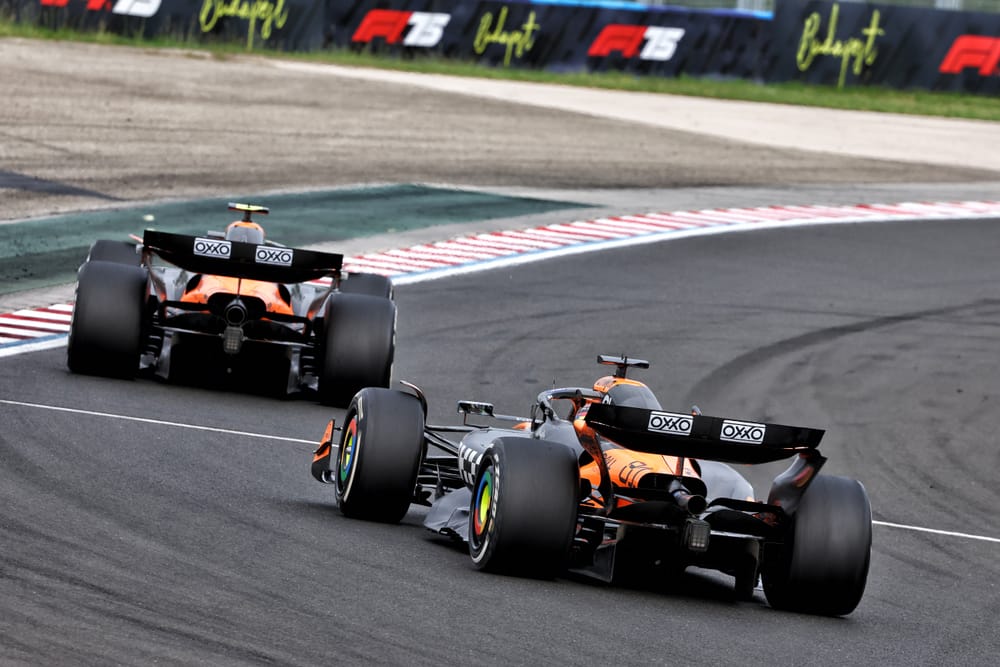McLaren did not intend for Lando Norris to switch to a winning one-stop strategy in Formula 1's Hungarian Grand Prix as it did not think it was possible pre-race and felt Oscar Piastri's two-stop was going to be the "dominant" tactic.
Norris backed out of an attempt to pass Piastri for second into Turn 1 at the start which led to him getting passed by George Russell and Fernando Alonso and dropping to fifth.
Though he cleared Alonso early, Norris spent the first stint stuck behind Russell - and after initially suggesting Norris might need to pit early, McLaren opted to extend instead.
While Piastri ran a conventional two-stop strategy along with early race leader Charles Leclerc, Norris's pace on older tyres made McLaren consider a one-stop instead, which Norris was happy to gamble on.
It proved to be the decisive call as while Piastri used an extended middle stint and tyre offset to pass an ailing Leclerc for second, he was not able to overtake Norris despite catching him with several laps to go.
Asked by The Race to explain Norris's alternate and winning strategy, and if the team factored in that it might be unfair on Piastri to beat him with a one-stop that was not offered to him due to the circumstances of the race, McLaren team boss Andrea Stella said: "When we extended, leaving Lando out, we didn't think that the one-stop would have been possible.
"But credit to Lando, he managed to put together some very strong sectors and laptimes with tyres that were relatively used.
"So we somehow convinced ourselves that the one-stop was starting to get in the game as we progressed in the first stint.
"It wasn't like entering the race with a one or a two stop and we would have picked.
"We thought that the two-stop would be the dominant strategy today."
Piastri missed any chance of realising a one-stop would be possible by pitting so early in his fight with Leclerc.
Stella said this was because Piastri's tyres were already fading - he had slipped back from Leclerc throughout the opening stint - and that the undercut was "worth a try" although McLaren's thinking was that it would have a bigger tyre advantage as the race wore on.
"We wanted to give a first go at trying to pass Leclerc," Stella said.
"We knew that there would be a second go later in the race and at the time the one-stop for Lando was outside of any cards.
"It was an option from a strategic point of view that we discovered while we were staying out with Lando and we saw that he was in a condition to put together some competitive laptimes."
The other key decision McLaren made was whether to pit Piastri a second time - once Leclerc had already made his second stop and thus released Piastri into the lead - or let him attempt an even less likely one-stop on much older hards than Norris.
Knowing a second stop would guarantee Piastri fell behind Norris, McLaren's preference was to try to give him enough of a tyre offset to be able to catch and pressure his team-mate.
"That would have meant being on an optimal two-stop," Stella said.
"So we wanted to ensure that thinking about Leclerc we were not deviating too much off an optimal two-stop because that would have been unfair to Oscar in relation to his competition with Lando.
"And we also checked with Oscar what his preference was and said if he wanted to have an opportunity to win the race, we thought that with enough tyre delta to Leclerc, Oscar would have had a chance anyhow.
"So the race unfolded pretty much as we hoped it would unfold in terms of tyre behaviour, which means tyres that lasted enough for a one-stop when we decided to keep Lando out, but also in the second stint, tyres and car pass that would have allowed Oscar to pass Leclerc.
"Actually the two strategies proved to be quite equivalent."
Piastri tried a couple of half moves on Norris into Turn 1 after catching him, coming closest with the second - but even then he locked up and had to avoid hitting his team-mate.
Stella had lightly criticised Piastri for a similar kind of move early in the Austrian GP, because a lock-up indicated a loss of control, but did not do so on this occasion.
"When you have two great drivers like Lando and Oscar who race for a victory in a Formula 1 grand prix and race for the drivers' championship, it's always going to be very close," he said.
"But that was firm racing, it was fair racing at the same time. It was definitely within our principles.
"We had a bit of a lock-up with Oscar but at the same time Lando left some space because he knew that Oscar would have been on the limit of braking."



